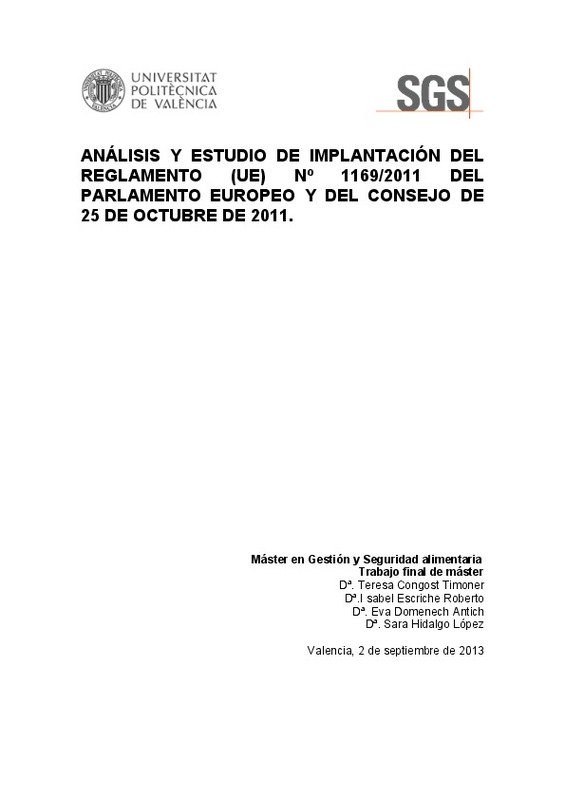|
Resumen:
|
[ES] Hoy en día la necesidad de estar bien informados es un hecho. La
sociedad, consumista en su mayoría, se deja vencer por las estrategias del
marketing pero a la vez necesita y quiere estar informada de lo que
consume. ...[+]
[ES] Hoy en día la necesidad de estar bien informados es un hecho. La
sociedad, consumista en su mayoría, se deja vencer por las estrategias del
marketing pero a la vez necesita y quiere estar informada de lo que
consume. Es por ello por lo que el Parlamento Europeo y el Consejo de la
Unión europea, reunidos, formalizaron un Reglamento europeo único para
exponer un correcto etiquetado que presente toda la información alimentaria
necesaria para consumidores, distribuidores y fabricantes. En este trabajo se
analizan los puntos más importantes y novedosos de dicho Reglamento, por
los cuales destaca, haciendo más comprensible el siguiente estudio. Con el
Reglamento estructurado se lleva a cabo un estudio del nivel de
implantación en diferentes sectores alimentarios e incluso en diferentes
países de dentro y de fuera del ámbito de aplicación. De entre los sectores
españoles como bebida, bollería, charcutería, congelados y alimentación
infantil se obtuvo un nivel de implantación superior al 76'5%, alcanzando una
media del 81'2%. La bollería, sector con menor grado de implantación, se
comparó con otros tres países, quedando España en tercer lugar. Se estudió
donde se encontraban la gran parte de las disconformidades, presentándose
en la errónea presentación de la información nutricional, y la ausencia de
una mayor señalización de las sustancias que pueden producir alergias o
intolerancias. Dado que el Reglamento no es de obligado cumplimiento
hasta el 13 de diciembre de 2014 solo podemos indicar que, hoy en día,
sólo el 8% de los productos españoles presentan total conformidad.
[-]
[EN] Nowadays the need to be well informed is a fact. The society, consumerist
mostly, put off by the marketing strategies but on the same time you need
and want to be informed of what they consume. It is for this reason ...[+]
[EN] Nowadays the need to be well informed is a fact. The society, consumerist
mostly, put off by the marketing strategies but on the same time you need
and want to be informed of what they consume. It is for this reason that the
European Parliament and the Council of the European Union together,
entered into a single European Regulation to determine those aspects for
proper labeling of all the information relevant food. This regulation also
benefits manufacturers and distributors to provide them with all the
information they need to properly label their products and it is they who are
going to have to study. This paper discusses the most important and
innovative points of the Regulation, which emphasizes more understandable
by the following study. With this structured Regulation is carried out a study
of the level of implementation of the regulation in different food sectors and
even in different countries within and outside the scope. Of Spanish and
beverage sectors, bakery, delicatessen, frozen and infant feeding resulted
implementation level more than 76'5%, with a mean between sectors of
81'2%. The pastries, as was the sector with the lowest implementation was
compared with other three countries, is leaving Spain on the third place. The
studies let us see where were much of disagreements appearing in the
erratic presentation of nutrition information, and emphasize absent of
substances that can cause allergies or intolerances. Because the regulation
is not enforceable until December the 13th, 2014 can only indicate that,
today, only 8% of the Spanish products have full compliance.
[-]
[CA] Hui en dia la necessitat d'estar ben informats és un fet. La societat,
consumista en la seua majoria, es deixa vèncer estratègies del màrqueting
però alhora necessita i vol estar informada del que consumeix. És per ...[+]
[CA] Hui en dia la necessitat d'estar ben informats és un fet. La societat,
consumista en la seua majoria, es deixa vèncer estratègies del màrqueting
però alhora necessita i vol estar informada del que consumeix. És per açò
pel que el Parlament Europeu i el Consell de la Unió europea, reunits, van
formalitzar un Reglament europeu únic per a expossar un correcte
etiquetatge que presente tota la informació alimentària necessària per a consumidors, distribuïdors i fabricants. En aquest treball s'analitzen els punts
més importants i nous d'aquest Reglament, pels quals destaca, fent més
comprensible el següent estudi. Amb el Reglament estructurat es duu a
terme un estudi del nivell d'implantació en diferents sectors alimentaris i fins i
tot en diferents països de dins i de fora de l'àmbit d'aplicació. D'entre els
sectors espanyols com la beguda, brioixeria, xarcuteria, congelats i
alimentació infantil es va obtindre un nivell d'implantació superior al 76'5%,
aconseguint-se una mitjana entre sectors del 81'2%. La brioixeria, sector
amb menor grau d'implantació, es va comparar amb altres tres països,
quedant Espanya en tercer lloc. Es va estudiar on es trobaven la gran part
de les disconformitats presentant-se en l'errònia presentació de la informació
nutricional, i l'absència d'una major senyalització de les substàncies que
poden produir al·lèrgies o intoleràncies. Atès que el Reglament no és
d'obligat compliment fins al 13 de desembre de 2014 solament podem
indicar que, avui dia, només el 8% dels productes espanyols presenten total conformitat.
[-]
|







